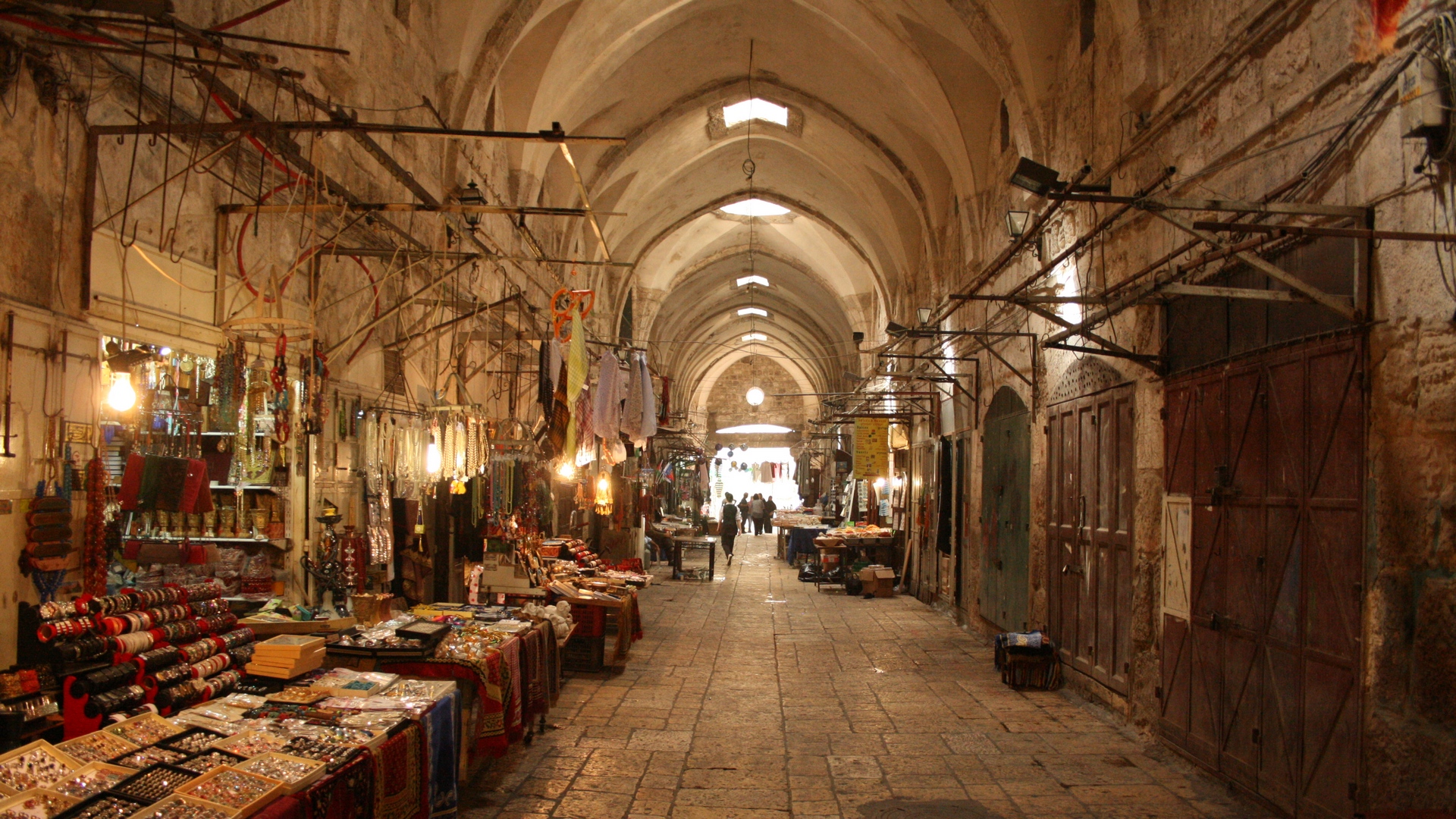Description
Property Name: The Cotton Merchants’ Market, Suq al-Qattanin (in Al-Masjid Al-Aqsa)
Inventory No: 972-2-16
Date of infill of the inventory form: 2020-07-22
Country (State party): Palestine
Province : Al Quds/Jerusalem
Town: Old town
Geographic coordinates: 31°46’40.61″N
35°14’1.62″E
Historic Period: Mamluk
Year of Construction: 1336 AC
Style:Early Islamic
Original Use: Market
Current Use: Market
Architect: Unknown
Significance
The Cotton Market is located to the west of the Al-Masjid Al-Aqsa Wall; It stretches between the doors “Al-Mutahrah” and “Al-Hadid”; Its gate is opposite the Dome of the Rock. The importance of its location stems from its proximity to the Al-Masjid Al-Aqsa and its openness.
Selection Criteria
ii. to exhibit an important interchange of human values, over a span of time or within a cultural area of the world, on developments in architecture or technology, monumental arts, town-planning or landscape design
iii. to bear a unique or at least exceptional testimony to a cultural tradition or to a civilization which is living or which has disappeared
vi. to be directly or tangibly associated with events or living traditions, with ideas, or with beliefs, with artistic and literary works of outstanding universal significance
State of Preservation
The “Cotton Market” is attributed to its origin (Prince Saif al-Din Tanakz al-Nasiri, the deputy of Damascus), which he established in the year (737 AH – 1336 AD), and he is one of the largest Mamluk state, and the most famous and most developed of its deputies, especially in the Sultanate of King Nasser Muhammad bin Qalawun (741-709 AH) (1309-1340 AD). This market was restored in 1929 by the Supreme Islamic Council.
References
ed. Auld, Sylvia and Hillenbrand, Robert; arch. survey by Yusuf Natsheh. Ottoman Jerusalem: the living city: 1517-1917. London: Altajir World of Islam Trust, 2000.
Al-Quds, A Historical Document. Organization of the Islamic Conference.
Bahat, Dan. A selection of Ottoman Structures in the old city of Jerusalem. Jerusalem: The Open University of Israel, 1990.
Bahat, Dan. Carta’s Historical Atlas of Jerusalem, 1983
Burgoyne, Michael Hamilton. Mamluk Jerusalem, an architectural study. Scorpion Publishing Ltd., Essex, England 1987
Creswell, K.A.C. A Short Account of Early Muslim Architecture. Penguin Books, Harmondswoth, 1958.
Duncan, Alistair, The Noble sanctuary: portrait of a holy place in Arab Jerusalem. London: Longman, 1972.
Elad, Amikam. Medieval Jerusalem and Islamic Holy Places, Ceremonies, Pilgrimage. |Brill Leiden, Netherlands, 1995.
Grabar, Oleg. Jerusalem, Constructing the Study of Islamic Art, Volume IV. Ashgate Publishing Company, Hampshire, 2005.
Grabar, Oleg. The Dome of the Rock. Thames and Hudson Ltd., London, 1996.
Ed. Hattstein, Markus, Delius. Peter. Islam Art and Architecture. Könemann Verlagsgesellshaft mbH, France, 2000.
Jerusalem Institute for Israel Studies, Statistical Yearbook of Jerusalem, 2002/03
Kroyanker, David. Jerusalem Architecture. Tauris Parke Books, London, 1994.
Najm, Raip Yusuf, The Treasures of Jerusalem. Arabic Cities Organization, Al-Beti Establishment, 1983.
Sha’th, Shawqi. Al-Quds Al-Shareef. ISESCO, Rabat,1995.
Wilson, Colonel Sir Charles W. Jerusalem, The Holy City. Ariel Publishing House, Jerusalem.
Flood, F.B. 1997. Umayyad Survivals and Mamluk Revivals: Qalawunid Architecture and the Great Mosque of Damascus. Muqarnas XIV: An Annual on the Visual Culture of the Islamic World. Gülru Necipoglu (ed). Leiden: E.J. Brill, 57-79.
Grabar, Oleg. The Haram al-Sharid: An Essay in Interpretation, BRIIFS vol.2 no.2 Autumn 2000.
Jarrar, Sabri. 1998. Suq al-Ma’rifa: An Ayyubid Hanbalite Shrine in al-Haram al-Sharif. Muqarnas XV: An Annual on the Visual Culture of the Islamic World. Gülru Necipoglu (ed.) Leiden: E.J. Brill, 71-100.
Khalidi, Walid. The Dome of the Rock. Retrieved from Saudi Aramco World website: http://www.saudiaramcoworld.com/issue/199605/the.dome.of.the.rock.htm
Khoury, Nuha N.N. 1993. The Dome of the Rock, the Ka’ba, and Ghumdan: Arab Myths and Umayyad Monuments. Muqarnas X: An Annual on Islamic Art and Architecture. Margaret B. Sevcenko (ed.). Leiden: E.J. Brill.
Laurent, B. and Riedlmayer, A. Restorations of Jerusalem and The Dome of The Rock and Their Political Significance, 1537-1928
Leisten, Thomas. 1996. Mashhad Al-Nasr: Monuments of War and Victory in Medieval Islamic Art. Muqarnas Volume XIII: An Annual on the Visual Culture of the Islamic World. Gülru Necipoglu (ed.). Leiden: E.J. Brill.
Rabbat, Nasser. 1989. The Meaning of the Umayyad Dome of the Rock. Muqarnas VI: An Annual on Islamic Art and Architecture. Oleg Grabar (ed.). Leiden: E.J. Brill.
Rabbat, Nasser. 1993. The Dome of the Rock Revisited: Some Remarks on al-Wasiti’s Accounts. Muqarnas X: An Annual on Islamic Art and Architecture. Margaret B. Sevcenko (ed.). Leiden: E.J. Brill.
Richard Ettinghausen, Oleg Grabar, Marilyn Jenkins-Madina (1987),The Art and Architecture of Islam 650-1250 c.e. (pp.28-34)
Yavuz, Yildirim. 1996. The Restoration Project of the Masjid al-Aqsa by Mimar Kemalettin (1922-26). Muqarnas Volume XIII: An Annual on the Visual Culture of the Islamic World. Gülru Necipoglu (ed.). Leiden: E.J. Brill.
UNESCO, (1995) General Conference Twenty-eighth Session Report
Archnet website: archnet.org
Organization of the Islamic Conference Research Centre for Islamic History, Art and Culture
AL-QUDS/JERUSALEM IN HISTORICAL PHOTOGRAPHS: İSTANBUL, 2 0 0 9.


